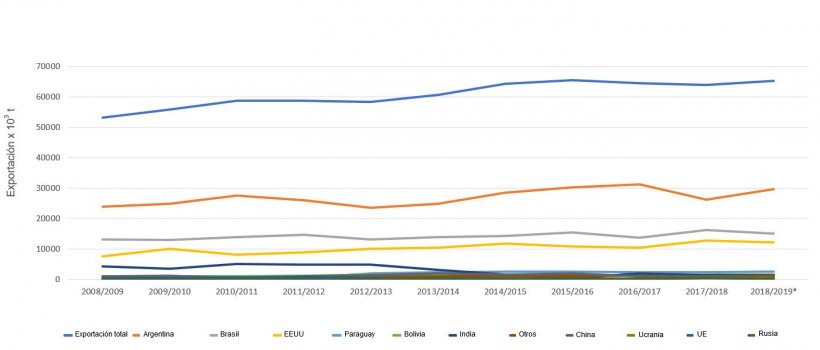Soybean meal is the source of protein and amino acids of choice worldwide in monogastric species; therefore, consistency of its quality and nutritional value is of special relevance. In this regard, the chemical composition and nutritional value of soybean meal can vary depending on its processing (Grieshop et al., 2003) and storage conditions, as well as the origin of the bean (Ravindran et al., 2014; -Rebollar et al., 2016). As a result, the potential variability in the profile and digestibility of the amino acids and in the energy content of the various soybean meals need to be taken into account to optimize production results. Due to its economic importance, the industry must know the factors that influence the correct assessment of soybean meal quality in order to optimize feed formulation.

Figure 1. Evolution of the 10 main exporters of soybean meal by campaigns. Source: FAS-USDA * Provisional data

The nutritional composition of soybean meal varies depending on the type of bean and the characteristics of the of cracking and dehulling processes to which it is subjected to facilitate extraction of the oil (Karr-Lilienlahl et al., 2005). The previous dehulling process can create particles with different fibre contents. In addition, part of the hull separated at the beginning of the process is sometimes re-added to the meal, thus reducing the protein content and the digestibility of the amino acids. The crude protein content (CP) varies between 46.7 and 48.5% for the high-protein meal and between 43 and 45% for the standard meal, whereas Lys levels are between 2.7 and 3.0% (FEDNA, 2017). The chemical composition of soybean meal, however, also varies depending on the latitude of the planting area, hours of light, weather and environmental conditions during the harvest season (Goldflus et al., 2016, Thakur and Hurburgh, 2007.) Accordingly, soybean meals from the US, Brazil and Argentina (leading exporters worldwide) may present higher than expected nutritional differences (figure 1.) Ravindran et al. and Lagos & Stein (2017) found that Brazilian soybean meals contained more CP than those from the US or Argentina. Likewise, differences in the composition of the protein fraction of the various soybean meals should be considered. Brazilian soybean meals usually contain less lysine, sulphur amino acids and threonine per unit of CP than those from the US or Argentina. In addition, soybean meals from the US usually contain less fibre and more sucrose than Brazilian meals, with intermediate values for meals from Argentina. As per the energy contents of soybean meal, the sugar contents or the potential variation in the protein digestibility, as well as the presence or absence of anti-nutritional factors (ANF) or Maillard reactions should be taken into account. These parameters can vary considerably depending on the origin of the bean and its processing (García-Rebollar et al., 2016).

Figure 2. Chemical composition of soybean according to FEDNA (2017)
Table 1. Chemical composition, amino acid profile and quality indicators of soybean meal protein and its porcine net energy value1 (García-Rebollar et al., 2016)
| Argentina | Brazil | USA | SEM8 | P-value | |
|---|---|---|---|---|---|
| No. samples | 170 | 165 | 180 | ||
| Specific analysis, % | |||||
| Ashes | 6.6x | 6.3y | 6.7x | 0.04 | <0.001 |
| Crude protein (CP) | 45.5y | 46.8x | 46.8x | 0.1 | <0.001 |
| Ethereal Extract (hydr. Ac.) | 1.7y | 1.8x | 1.7y | 0.04 | 0.04 |
| Sucrose | 6.8y | 5.7z | 7.4x | 0.07 | <0.001 |
| Stachyose | 5.0y | 4.6z | 5.6x | 0.04 | <0.001 |
| Raffinose | 1.2y | 1.4x | 1.0z | 0.02 | <0.001 |
| NDF2 | 9.0y | 10.4x | 7.9z | 0.12 | <0.001 |
| Amino acids profile, CP % | |||||
| Lysine | 6.11y | 6.07z | 6.17x | 0.005 | <0.001 |
| Methionine | 1.37x | 1.33y | 1.37x | 0.002 | <0.001 |
| Cysteine | 1.51x | 1.48y | 1.51x | 0.003 | <0.001 |
| Threonine | 3.94x | 3.89z | 3.92y | 0.002 | <0.001 |
| Tryptophan | 1.37x | 1.35y | 1.37x | 0.002 | <0.001 |
| CP quality indicators | |||||
| UA3, mg N/g | 0.014y | 0.026x | 0.022x | 0.002 | <0.001 |
| PDI4, % | 16.0y | 15.0y | 19.5x | 0.324 | <0.001 |
| KOH5, % | 81.2y | 82.0y | 86.1x | 0.328 | <0.001 |
| TIA6, mg/g MS | 2.8y | 2.9y | 3.5x | 0.053 | <0.001 |
| Estimated analysis | |||||
| EN7, kcal/kg | 2.051y | 2.022z | 2.085x | 3.78 | <0.001 |
1 All results are given for a dry matter content of 88%
2 Neutral detergent fibre
3 Urease activity
4 Protein Dispersibility Index
5 Protein solubility in KOH
6 Trypsin inhibitory activity
7 Net energy Estimated as per Noblet et al. (2003)
8 Standard Error of the Mean
Trypsin inhibitors (TI) are the main ANF present in soybean meal, and they can affect the digestibility of amino acids. In addition, the presence of oligosaccharides (stachyose and raffinose) should be taken into consideration when assessing their nutritional quality. A correct thermal treatment however, can reduce the quantity and activity of the TI, thus increasing the nutritional value and digestibility of the amino acids in soybean meal. Nonetheless, it has to be borne in mind that an insufficient heat treatment will not reduce TI activity, and that overheating can generate Maillard reactions that decrease the digestibility of the protein fraction (Fontaine et al, 2007; González-Vega et al, 2011.) The methods most commonly used in the sector to determine the protein quality of soybean meal are the urease test, KOH solubility and protein dispersibility index PDI). In general, these quality indicators favour the use of soybean meal of US origin versus soybean meal of Brazilian or Argentine origin, possibly due to a less aggressive thermal processing or to differences in the beans answer to the heat treatment depending on the country of origin. The swine feed manufacturing industry must take into account, based on its economic importance due to high levels of use, the nutritional variability of the soybean meals available in the market. Therefore, the origin of the bean, the characteristics of its processing and storage must be taken into account for an adequate assessment of the nutritional quality of the meals.

Soybean meal United Soybean Board




